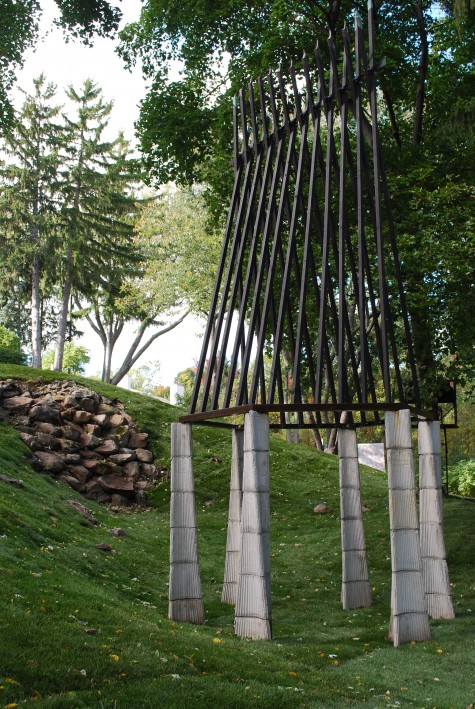 Given that I took this picture September 24, why wouldn’t I be unprepared for the weather here this past week? Just three weeks ago, I still had my summer. Though describing any Michigan weather as “ordinary” is glossing over the truth, our weather ordinarily cools off at a slow enough pace to make keeping up with the job of putting the garden to sleep relatively easy. My fall cleanup and shovelling out is based on the distinction I draw between gardening, and housekeeping.
Given that I took this picture September 24, why wouldn’t I be unprepared for the weather here this past week? Just three weeks ago, I still had my summer. Though describing any Michigan weather as “ordinary” is glossing over the truth, our weather ordinarily cools off at a slow enough pace to make keeping up with the job of putting the garden to sleep relatively easy. My fall cleanup and shovelling out is based on the distinction I draw between gardening, and housekeeping.
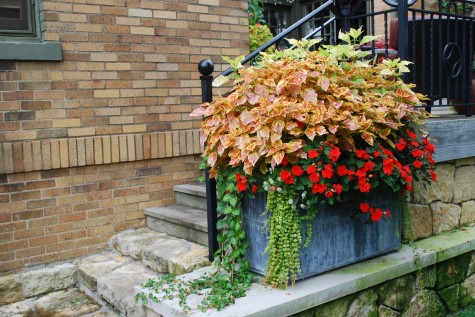 I have seen those properties that look as though every shred of organic debris has been blown, vacuumed up and disposed of weekly; anyone who has inadvertently turned a blower on themselves realize what an invasion they are. Every green leaf looks dusted; every surface has been swept, every shred or organic debris is bagged and removed. The stone is scrubbed clean, and the cushions are only on the furniture when company is in attendance. I like the look of cultivated soil as well as the next person, but all of the above is housekeeping, not gardening. Years ago a gardener whom I greatly respect, Marge Alpern, told me she disturbed her plants as little as possible. She maintained that plants can be worried such that they refuse to prosper. I think this is a point well taken. I will not take on the perennial gardens until much later in the fall.
I have seen those properties that look as though every shred of organic debris has been blown, vacuumed up and disposed of weekly; anyone who has inadvertently turned a blower on themselves realize what an invasion they are. Every green leaf looks dusted; every surface has been swept, every shred or organic debris is bagged and removed. The stone is scrubbed clean, and the cushions are only on the furniture when company is in attendance. I like the look of cultivated soil as well as the next person, but all of the above is housekeeping, not gardening. Years ago a gardener whom I greatly respect, Marge Alpern, told me she disturbed her plants as little as possible. She maintained that plants can be worried such that they refuse to prosper. I think this is a point well taken. I will not take on the perennial gardens until much later in the fall.
 A series of nights with temperatures hovering in the mid thirties left my pots looking like this-devastated. It does not matter one bit that I know this day is coming, I am never ready for it, nor do I like it. I do not like to let go. On a much more dramatic scale than the time changing to daylight savings, I adjust slowly, and poorly.
A series of nights with temperatures hovering in the mid thirties left my pots looking like this-devastated. It does not matter one bit that I know this day is coming, I am never ready for it, nor do I like it. I do not like to let go. On a much more dramatic scale than the time changing to daylight savings, I adjust slowly, and poorly.
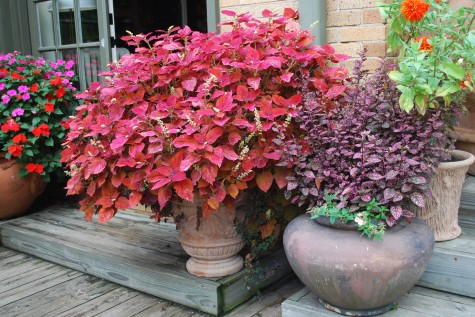 Coleus are astonishingly intolerant of cold weather. Anyone who does poorly with them is probably planting them out too early; every plant thrives in some conditions, and sulks in all else. This five foot diameter fiery orange ball was glorious all season; in late August the corgis were breaking off the branches encroaching on the doorway. They keep the extreme understory clear of any obstructions.
Coleus are astonishingly intolerant of cold weather. Anyone who does poorly with them is probably planting them out too early; every plant thrives in some conditions, and sulks in all else. This five foot diameter fiery orange ball was glorious all season; in late August the corgis were breaking off the branches encroaching on the doorway. They keep the extreme understory clear of any obstructions.
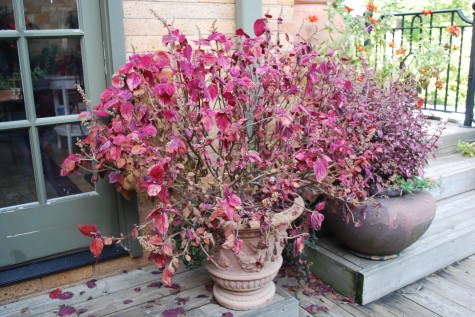 In what seemed like the blink of an eye my fireball shed almost every leaf. Unlike the gingko tree which sheds every leaf on that certain perfect fall day, leaving a beautiful pool of yellow on the ground, the coleus leaves dessicate, drop, and disappear before you can even mourn properly.
In what seemed like the blink of an eye my fireball shed almost every leaf. Unlike the gingko tree which sheds every leaf on that certain perfect fall day, leaving a beautiful pool of yellow on the ground, the coleus leaves dessicate, drop, and disappear before you can even mourn properly.
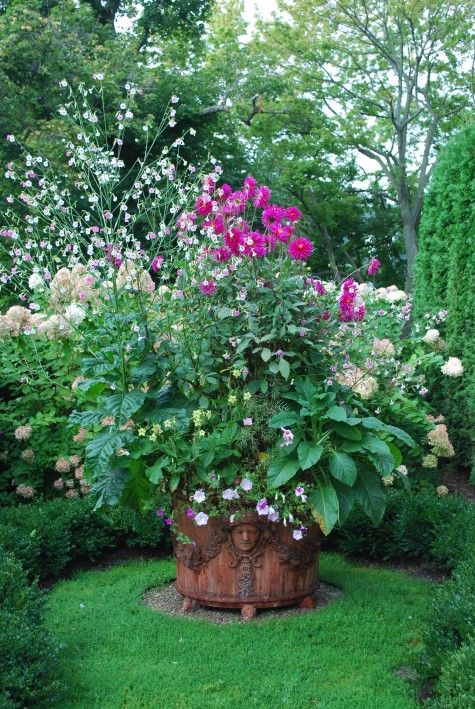 My English-made Italian style pots were home to the biggest bouquet I have ever grown. The nicotiana mutabilis got busy throwing spikes in September, and the dahlias were blooming profusely. I like that extravagant and exuberant look. No matter how the day had gone, I could go home and congratulate myself on having grown one of the annual wonders of the western world. You may be laughing, but how the look of it pleased and cheered me.
My English-made Italian style pots were home to the biggest bouquet I have ever grown. The nicotiana mutabilis got busy throwing spikes in September, and the dahlias were blooming profusely. I like that extravagant and exuberant look. No matter how the day had gone, I could go home and congratulate myself on having grown one of the annual wonders of the western world. You may be laughing, but how the look of it pleased and cheered me.
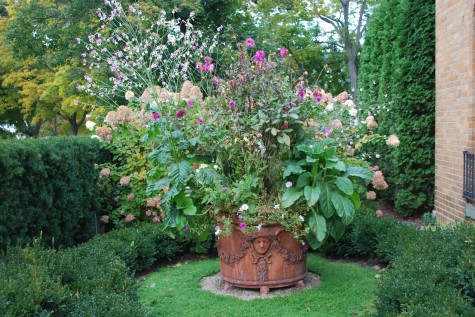 Though the nicotiana mutabilis is yet bravely defending its home, the cold pierced the heart of the whole. Buck is always amazed and amused and the depth and breadth of the despair which attends the beginning of the end of my gardening year. I alternately rage and whine-he murmurs, and pours the wine.
Though the nicotiana mutabilis is yet bravely defending its home, the cold pierced the heart of the whole. Buck is always amazed and amused and the depth and breadth of the despair which attends the beginning of the end of my gardening year. I alternately rage and whine-he murmurs, and pours the wine.
 This sister to my pots, adapted for use as a fountain, bears all the signs of a season’s worth of mineral laden water, weather,heat and growth. Does that gorgeous Italianate face not seem completely grief stricken?
This sister to my pots, adapted for use as a fountain, bears all the signs of a season’s worth of mineral laden water, weather,heat and growth. Does that gorgeous Italianate face not seem completely grief stricken?

It will no doubt take time, but I will get to thinking about what I will do with these pots for the holidays, and the winter. But for the moment, I am inconsolable.
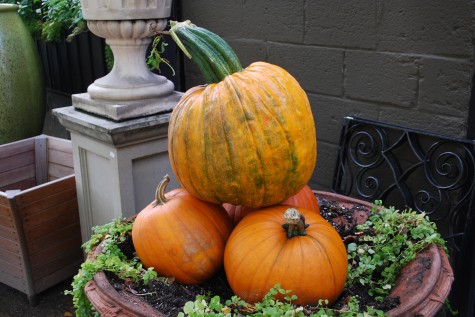 Whether I am drawing a plan, arranging some flowers, building a topiary sculpture, or staging a display, my first move is to determine the order of events. The big gesture comes first. In a landscape plan, I determine the center of interest, or organizing element, and place it. If it is a pool, that pool is assigned a size and a location; any other design is keyed to and in support of that initial decision. If the pool is centered in a space, I work from the middle to the edges of my paper. If that pool is located on a wall at the far end of my space, I would work from back to front, in tandem with establishing the views. As the topiaries that had spent the summer in these pots needed the shelter of a greenhouse, I had four empty pots in search of a reason to be. The idea of these pots overflowing with pumpkins squashes and gourds in some sculptural way had appeal. As these pots are large, a center of interest at a height pleasingly proportional to their width needed to be set first. I used a trio of medium sized pumpkins to get my big pumpkin with its giant stem at the right finished height.
Whether I am drawing a plan, arranging some flowers, building a topiary sculpture, or staging a display, my first move is to determine the order of events. The big gesture comes first. In a landscape plan, I determine the center of interest, or organizing element, and place it. If it is a pool, that pool is assigned a size and a location; any other design is keyed to and in support of that initial decision. If the pool is centered in a space, I work from the middle to the edges of my paper. If that pool is located on a wall at the far end of my space, I would work from back to front, in tandem with establishing the views. As the topiaries that had spent the summer in these pots needed the shelter of a greenhouse, I had four empty pots in search of a reason to be. The idea of these pots overflowing with pumpkins squashes and gourds in some sculptural way had appeal. As these pots are large, a center of interest at a height pleasingly proportional to their width needed to be set first. I used a trio of medium sized pumpkins to get my big pumpkin with its giant stem at the right finished height. 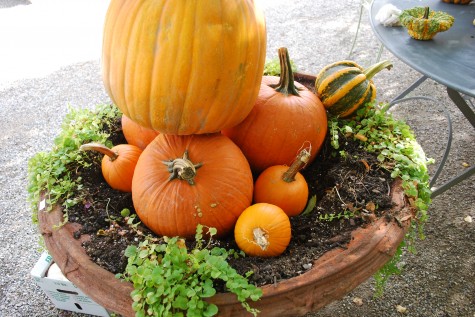 When working with rounded forms, it rarely works to use a filler material for height. Someplace your filler will show, and give the impression your slip is showing. Trying to cover up a not for viewing interior structure invariably looks like a cover up. Whatever portion of these support pumpkins might show in the finished piece, that portion will look like part of the arrangement. I would not have the faintest idea about how to turn pie pumpkins into pie, but I do know how to use them to provide crooks and crannies to set my prized specimen gourds. I set these beginning pumpkins at an angle which makes their swooping stems part of the action of the sculpture. This helps to make the sculpture look graceful. Every stem set straight up risks that soldierly, grocery store display look.
When working with rounded forms, it rarely works to use a filler material for height. Someplace your filler will show, and give the impression your slip is showing. Trying to cover up a not for viewing interior structure invariably looks like a cover up. Whatever portion of these support pumpkins might show in the finished piece, that portion will look like part of the arrangement. I would not have the faintest idea about how to turn pie pumpkins into pie, but I do know how to use them to provide crooks and crannies to set my prized specimen gourds. I set these beginning pumpkins at an angle which makes their swooping stems part of the action of the sculpture. This helps to make the sculpture look graceful. Every stem set straight up risks that soldierly, grocery store display look.  As I am interested in placing the largest gourds next, and then, arranging with color in mind, I need to look at averything I have available all at once. This can be quite a nuisance when building a stone wall, but I would not know how to construct it otherwise. In designing a landscape, a lot of shapes, textures and volumes need to be available to your mind’s eye, all at once. I am only good for a random thought that might be pertinent when I am tired; it takes energy to concentrate enough to turn off the daily noise and design. This is easy-get the gourds out, and spread them around.
As I am interested in placing the largest gourds next, and then, arranging with color in mind, I need to look at averything I have available all at once. This can be quite a nuisance when building a stone wall, but I would not know how to construct it otherwise. In designing a landscape, a lot of shapes, textures and volumes need to be available to your mind’s eye, all at once. I am only good for a random thought that might be pertinent when I am tired; it takes energy to concentrate enough to turn off the daily noise and design. This is easy-get the gourds out, and spread them around.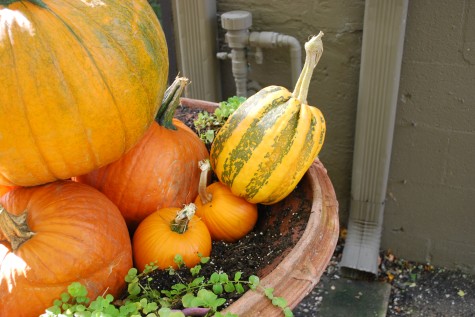 My big beautiful squashes get placed next. When I look at the four pots from the drive, I see that the pots furthest from my eye will need more emphasis than the pots close to my eye; bigger material is a good way to get what is far away to read better. A small pie pumpkin enables me to tilt the squash out over the edge of the pot, and feature the stem.
My big beautiful squashes get placed next. When I look at the four pots from the drive, I see that the pots furthest from my eye will need more emphasis than the pots close to my eye; bigger material is a good way to get what is far away to read better. A small pie pumpkin enables me to tilt the squash out over the edge of the pot, and feature the stem. 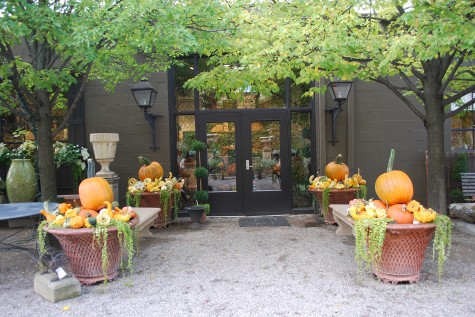 I finish placing all the large gourds, and stand back for a look. Though not so readily apparent in this picture, I have placed more of the pale or light colored gourds in the rear pots, and the darker colored gourds in the front pots. Dark colors do not read well at a distance, so placing them up front makes the detail of their shape and color read better. Pale colors read fine at a distance, and highlight dark colors placed in front of them. The pots are ready for the little bits-the smallest gourds finish and refine the shape of the overall arrangement. In a landscape, I might be planting roses at this stage, or groundcover as part of the finishing touches.
I finish placing all the large gourds, and stand back for a look. Though not so readily apparent in this picture, I have placed more of the pale or light colored gourds in the rear pots, and the darker colored gourds in the front pots. Dark colors do not read well at a distance, so placing them up front makes the detail of their shape and color read better. Pale colors read fine at a distance, and highlight dark colors placed in front of them. The pots are ready for the little bits-the smallest gourds finish and refine the shape of the overall arrangement. In a landscape, I might be planting roses at this stage, or groundcover as part of the finishing touches.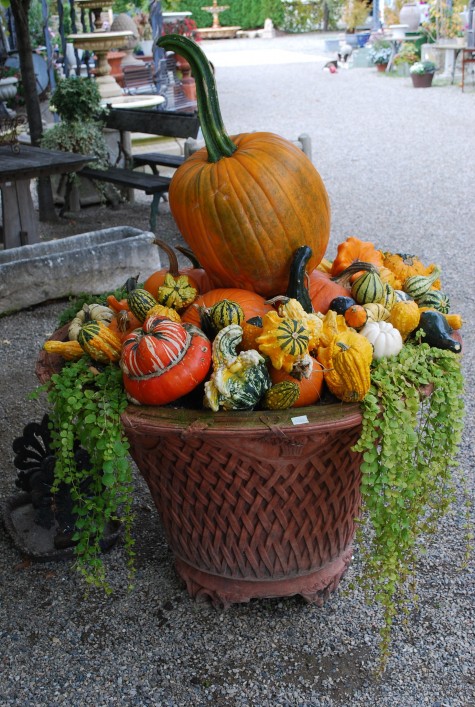 The idea is suggest a casual and not too fussy an arrangement. In fact, ordering the placement of sizes permits an arrangement where all the pieces are built sensibly from a large base supporting the fine detail-both visually, and physically. In a large flower arrangement, the interlocking big stems under water provide a framework that will hold the smaller stems where you want them. In a landscape, a long walk indicates how a garden is meant to be experienced-but it also provides weight and organization to the smaller elements you otherwise might not notice. All the elements of any composition need to interlock for a strong presentation of the whole. This front pot features dark and intense colors, with dashes of pale colors here and there.
The idea is suggest a casual and not too fussy an arrangement. In fact, ordering the placement of sizes permits an arrangement where all the pieces are built sensibly from a large base supporting the fine detail-both visually, and physically. In a large flower arrangement, the interlocking big stems under water provide a framework that will hold the smaller stems where you want them. In a landscape, a long walk indicates how a garden is meant to be experienced-but it also provides weight and organization to the smaller elements you otherwise might not notice. All the elements of any composition need to interlock for a strong presentation of the whole. This front pot features dark and intense colors, with dashes of pale colors here and there.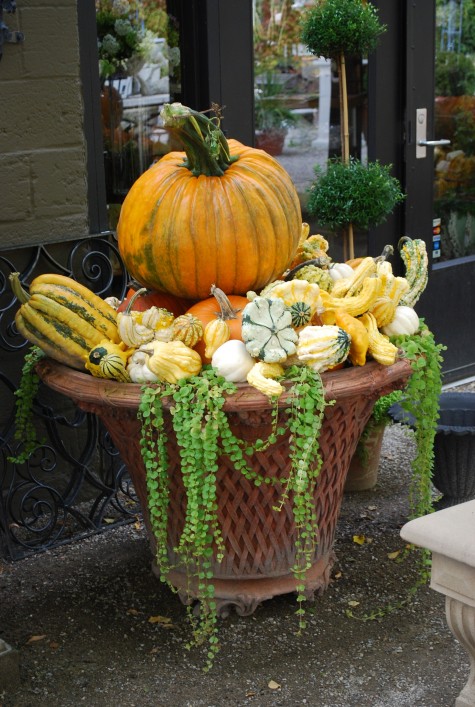 This rear pot set in a much darker environment relies on the interaction of pale colored shapes for good visibility. The varying shapes and colors of all the little noisy gourds emphasize the mass and grace of the shape of my starring pumpkin.
This rear pot set in a much darker environment relies on the interaction of pale colored shapes for good visibility. The varying shapes and colors of all the little noisy gourds emphasize the mass and grace of the shape of my starring pumpkin.

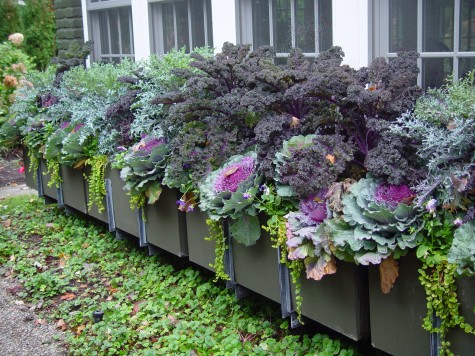 Window boxes of size permit expression of size. These boxes are viewed primarily from a garden room indoors, so big and striking, and not too tall, is the order of the day. As they face the south, and are somewhat protected from freezing winds and cold temperatures, these boxes prosper late into the fall season and through Thanksgiving.
Window boxes of size permit expression of size. These boxes are viewed primarily from a garden room indoors, so big and striking, and not too tall, is the order of the day. As they face the south, and are somewhat protected from freezing winds and cold temperatures, these boxes prosper late into the fall season and through Thanksgiving. Whomever it was who invented stick stacks, I thank them. These 6 foot stacks comprised of wood cut into quarter inch by quarter inch squares are uniformly vertical when they go in a pot. A piece of steel rebar is driven deep into the pots, and the stack wired to it. This keeps the centerpiece from tilting. Funny how an element askew has that air of neglect about it. I like to see people keeping up the appearance of their homes from the street. Stick stacks change in appearance with exposure to weather. As the wood absorbs moisture from the air, they curve away from the center in a very graceful way. The preserved green eucalyptus weathers just about anything.
Whomever it was who invented stick stacks, I thank them. These 6 foot stacks comprised of wood cut into quarter inch by quarter inch squares are uniformly vertical when they go in a pot. A piece of steel rebar is driven deep into the pots, and the stack wired to it. This keeps the centerpiece from tilting. Funny how an element askew has that air of neglect about it. I like to see people keeping up the appearance of their homes from the street. Stick stacks change in appearance with exposure to weather. As the wood absorbs moisture from the air, they curve away from the center in a very graceful way. The preserved green eucalyptus weathers just about anything. Tender is a fabulous dress shop that is known for its cutting edge fashion. Their fall pots are dressy. Maple leaves coated in copper shine, as do the pumpkins with a dusting of gold. Integrifolia dyed an intense shade of fall orange compliment the dyed pencil thin willow sticks. Orange and white pansies complete the ensemble.
Tender is a fabulous dress shop that is known for its cutting edge fashion. Their fall pots are dressy. Maple leaves coated in copper shine, as do the pumpkins with a dusting of gold. Integrifolia dyed an intense shade of fall orange compliment the dyed pencil thin willow sticks. Orange and white pansies complete the ensemble.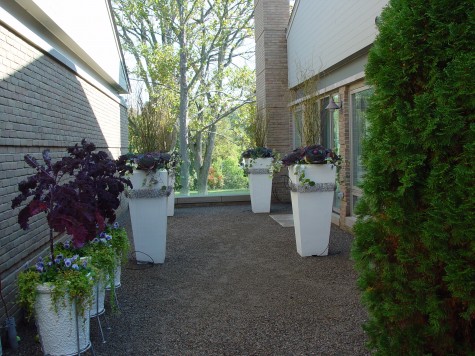 This narrow courtyard, part of a condominium, is organized around four very large white concrete pots inlaid with bands of curved stainless steel wire. Fiber pots painted white in galvanized steel stands are home to my client’s tomato plants in the summer; the tall kale, pansies, and creeping jenny compliment the cabbages and ivy in the concrete pots in both form and feeling.
This narrow courtyard, part of a condominium, is organized around four very large white concrete pots inlaid with bands of curved stainless steel wire. Fiber pots painted white in galvanized steel stands are home to my client’s tomato plants in the summer; the tall kale, pansies, and creeping jenny compliment the cabbages and ivy in the concrete pots in both form and feeling. 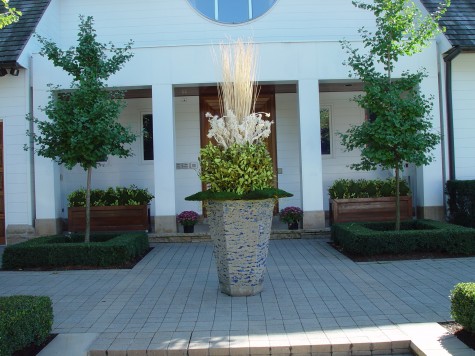 Lime integrifolia and diamond shaped moss pillows help create a clean and more modern look; not every client is enamoured of pumpkins and the like. Bleached sticks and pods complete the look.
Lime integrifolia and diamond shaped moss pillows help create a clean and more modern look; not every client is enamoured of pumpkins and the like. Bleached sticks and pods complete the look.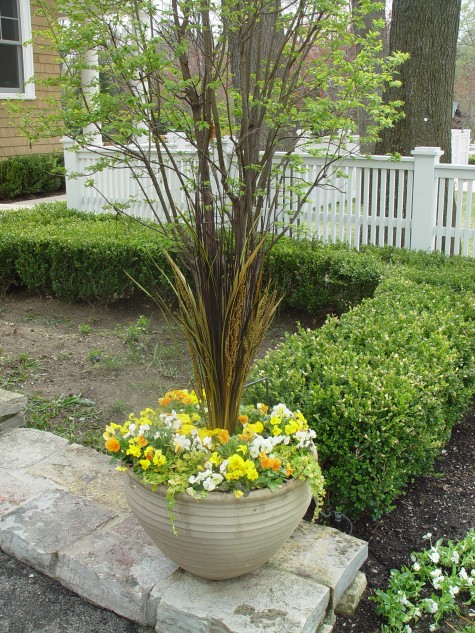
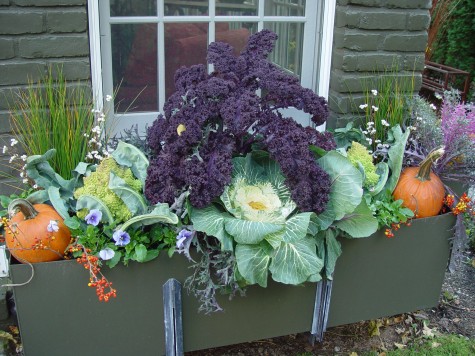
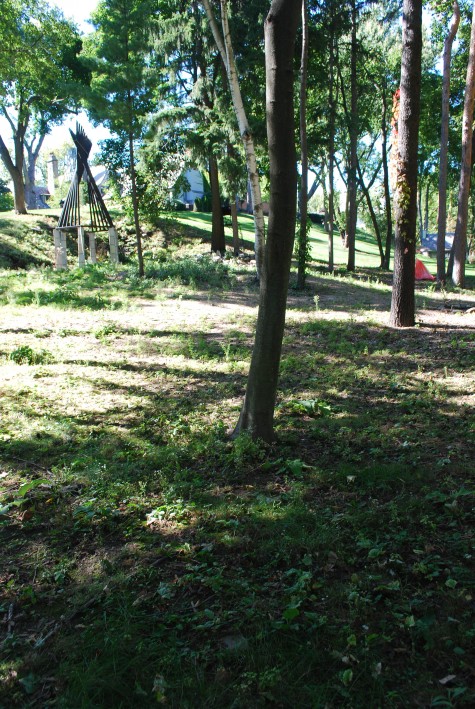 For years my client and I had been looking at a certain giant blob of a thicket on her property. Lanky buckthorn, lilac and other unkempt and untended shrubs had made the space impenetrable. The fact that the area was on a steep slope made investigating what was there all the more difficult.Not knowing what was in there made it easy to just mow around it, and act like it was part of a landscape. Every so often she would talk about what might be in there; this went on for some years.
For years my client and I had been looking at a certain giant blob of a thicket on her property. Lanky buckthorn, lilac and other unkempt and untended shrubs had made the space impenetrable. The fact that the area was on a steep slope made investigating what was there all the more difficult.Not knowing what was in there made it easy to just mow around it, and act like it was part of a landscape. Every so often she would talk about what might be in there; this went on for some years. 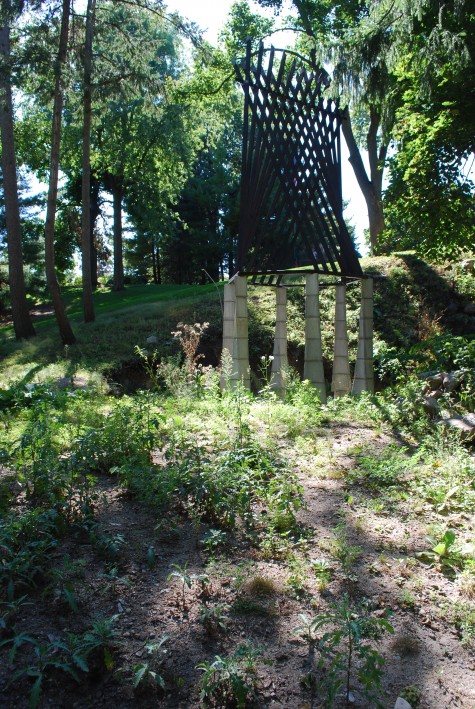 One day she called to say she had clear cut the entire spot, and discovered an old rock waterfall and pool. No doubt it dated back to the 1920’s. The precipitous drop, lined with giant rocks, was entirely stable. There was a lot of discussion about restoring the watefall and pool, which led to some discussion of a new fountain; more years went by. One day she called to say she wanted me to look at the space again-I thought as the thicket was threatening to grow back-we were being chased for a plan. How like her to install an enormous concrete and wood sculpture in the center of the old pool. This is so distinctively her way of working things out. Making a move like that was forcing everyone’s hand. I told her I thought a sculpture of this size and proportion needed its own park.
One day she called to say she had clear cut the entire spot, and discovered an old rock waterfall and pool. No doubt it dated back to the 1920’s. The precipitous drop, lined with giant rocks, was entirely stable. There was a lot of discussion about restoring the watefall and pool, which led to some discussion of a new fountain; more years went by. One day she called to say she wanted me to look at the space again-I thought as the thicket was threatening to grow back-we were being chased for a plan. How like her to install an enormous concrete and wood sculpture in the center of the old pool. This is so distinctively her way of working things out. Making a move like that was forcing everyone’s hand. I told her I thought a sculpture of this size and proportion needed its own park.  The sculptor had sunk concrete pilings in giant sonatubes. Still visible in the above picture, it was apparent no small amount of grading was needed. My client was concerned that the pool would hold water. The rim of outside soil needed to be taken down. A giant pile of rocks collected from the first clear cutting went into the hole first. Trapping water near the sculpture would not be a good idea.
The sculptor had sunk concrete pilings in giant sonatubes. Still visible in the above picture, it was apparent no small amount of grading was needed. My client was concerned that the pool would hold water. The rim of outside soil needed to be taken down. A giant pile of rocks collected from the first clear cutting went into the hole first. Trapping water near the sculpture would not be a good idea.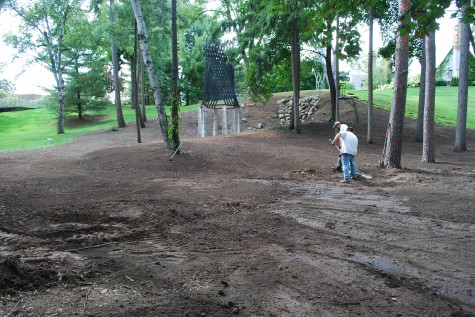 A skid steer made quick work of removing the weedy growth that had begun to take hold. I have watched the history channel television series called “Life After People” with great interest. It is astonishing how little time it takes for untended ground to go to rack and ruin. Nature abhors a vacuum; any bare dirt will have something going on in short order. Ignore a space, and nature will take over in your absence.
A skid steer made quick work of removing the weedy growth that had begun to take hold. I have watched the history channel television series called “Life After People” with great interest. It is astonishing how little time it takes for untended ground to go to rack and ruin. Nature abhors a vacuum; any bare dirt will have something going on in short order. Ignore a space, and nature will take over in your absence. 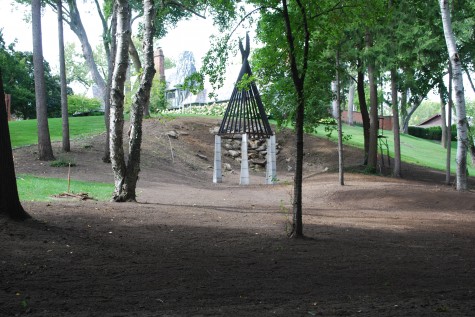 The front edge of the old pool was lowered to permit water to escape. I so love this point in a landscape project; bare sculpted dirt is incredibly beautiful. A landscape of evergreens planted in sculpted, cultivated soil-a landscape of my dreams. Barked areas in a garden leave me cold-I like to cover the ground with plants, or see dirt. I mulch strictly to conserve moisture in the soil. The pattern of light and dark on the ground here is telling. The old waterfall and pool were situated in a patch of sun. The sculpture benefits from this.
The front edge of the old pool was lowered to permit water to escape. I so love this point in a landscape project; bare sculpted dirt is incredibly beautiful. A landscape of evergreens planted in sculpted, cultivated soil-a landscape of my dreams. Barked areas in a garden leave me cold-I like to cover the ground with plants, or see dirt. I mulch strictly to conserve moisture in the soil. The pattern of light and dark on the ground here is telling. The old waterfall and pool were situated in a patch of sun. The sculpture benefits from this. 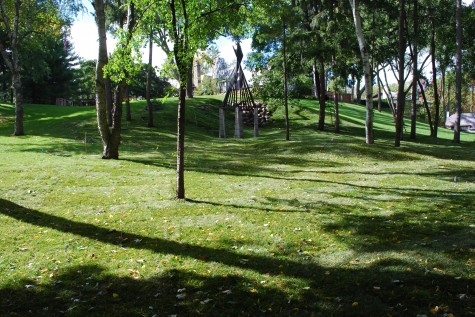 New lawn softens all the hard edges. The rolling, swelling and dipping of the ground makes for a big fluid situation for the starkly vertical sculpture on its big legs. They look good together.
New lawn softens all the hard edges. The rolling, swelling and dipping of the ground makes for a big fluid situation for the starkly vertical sculpture on its big legs. They look good together.  The fountain rockwork we left exposed. It is a part of the history of the property. Practically speaking, I would never have removed those giant stones; they have stabilized soil existing at a very steep angle. In the spring, my client will be able to pick and choose what she mows, and what she chooses to let be. There is a sculptural element yet to come-the decision about how and where to cut the lawn.
The fountain rockwork we left exposed. It is a part of the history of the property. Practically speaking, I would never have removed those giant stones; they have stabilized soil existing at a very steep angle. In the spring, my client will be able to pick and choose what she mows, and what she chooses to let be. There is a sculptural element yet to come-the decision about how and where to cut the lawn.